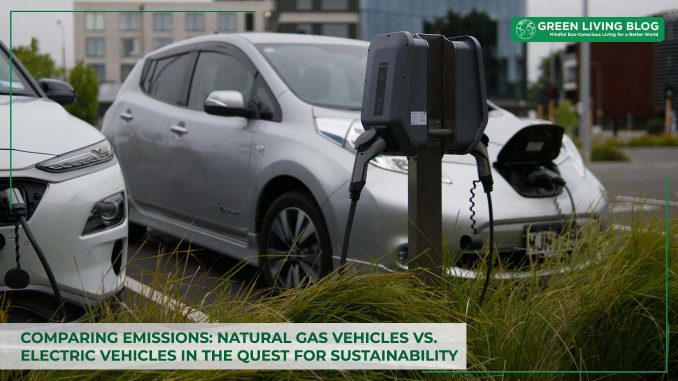
Vehicle fuel sources have become hot topics in sustainability debates.
Many drivers want to know whether electric cars are the best option to lower emissions and how natural gas vehicles compare.
Assessing Emissions Sources

Although people commonly think of electric cars as emission-free, that’s not quite true. These automobiles do not produce tailpipe emissions as their gas-powered counterparts do. However, there are other types to consider.
Whether someone measures emissions with electric or natural gas cars, they should account for emissions produced during manufacturing or end-of-life recycling, if possible. Similarly, if manufacturers operate in the circular economy by recycling, reusing and extending the lifespan of their products, those conscious choices will reduce emissions.
Accurate emissions comparisons also require measuring non-exhaust emissions. A 2025 study centred on those emissions, analysing 24 electric, hybrid and gas-powered vehicles. The results indicated electric vehicles generally make fewer brake and tire emissions than gas-powered vehicles. However, the opposite is true if less than 15% of the driving happens in the city.
The researchers also identified electric vehicles’ regenerative features as emissions reducers. That’s because they use electric motors to slow the automobiles rather than traditional brake pads, which wear down and produce emissions.
Moving Away From Diesel
People making emission comparisons between electric and natural gas vehicles must also consider the impact of what they previously used and whether either of these alternatives would be better. Another way to look at things is to measure the number of vehicles they own or use. For example, gradual transitions to make large fleets greener can make significant differences, even if they take time to complete.
Fueling natural gas vehicles results in 20% fewer emissions compared to diesel counterparts. Additionally, since compressed natural gas automobiles have sealed systems, they do not release evaporative emissions. Consider a company that uses hundreds of diesel vehicles for at least eight hours per day over long distances and frequently refuels them. That’s a prime case where it could make sense to gradually transition to natural gas vehicles to reduce emissions.
India’s Blue Energy Motors manufactures liquid natural gas-powered trucks that give industrial customers greener alternatives to diesel trucks. The company’s efforts align with the nation’s goal of achieving net-zero emissions by 2070. When fleet decision-makers see that more sustainable commercial solutions are widely available, they should be more open to adopting them.
Statistics from Blue Energy Motors indicated its trucks had caused a 10,000-ton reduction in carbon dioxide emissions. Transitioning to natural gas from diesel is also more convenient because specialty retrofitters can convert many light and medium-duty models. That means fleet managers can keep using the same vehicles in more eco-friendly ways.
Examining Energy-Related Emissions

Comparisons should include investigations into the energy sources powering them. In the case of electric vehicles, taking the electricity from clean sources is ideal because fossil fuel-based options raise the associated emissions. Consumers can bypass those effects by using chargers powered by renewable energy. Although these chargers are more challenging to find than conventional ones, more manufacturers have gradually begun offering them.
When researchers examined liquid natural gas emissions in a 2024 study, they measured the carbon footprint over 20 years and included activities such as processing, transportation and storage. They found that the carbon footprint was 33% larger than that of coal if accounting for processing and shipping.
However, the group also looked at the effects over a century-long timeline, resulting in a smaller carbon footprint overall but still one larger than coal’s. The group uncovered interesting details about which factors cause higher emissions, too.
For example, the tankers used to transport liquid natural gas emit methane, which is more than 80 times more harmful to the Earth’s atmosphere than carbon dioxide. Steam powered previous versions of those vessels, and although these newer ones are more fuel-efficient and have lower carbon dioxide emissions, the methane emitted during transport is still problematic and can range from 3.9% to 8.1% of the total emissions. The natural gas liquefication process also causes methane emissions, representing about 8.8% of the total.
This breakdown shows the importance of considering the entire life cycle of energy sources when calculating emissions between natural gas and electric vehicles. Otherwise, you could get an incomplete picture.
Considering All Factors
Although emissions calculations are important when evaluating natural gas and electric vehicles, getting accurate results requires understanding all sources and comparing the outcomes with the automobiles you’re currently using. Paying attention to the details encourages results you can trust.
![]()
Author Profile
- Passionate content creator, contributor, freelance writer and content marketing allrounder.
Latest entries
 EnvironmentNovember 18, 2025What Are Ecological Surveys? Definition, Purpose, and Process
EnvironmentNovember 18, 2025What Are Ecological Surveys? Definition, Purpose, and Process BusinessOctober 23, 2025Legionnaires’ Disease: 3 Essential Actions to Control Risk While Supporting Sustainability
BusinessOctober 23, 2025Legionnaires’ Disease: 3 Essential Actions to Control Risk While Supporting Sustainability EnvironmentJuly 21, 2025Why Fat Balls Are Good For Your Local Bird Population
EnvironmentJuly 21, 2025Why Fat Balls Are Good For Your Local Bird Population Green Home GuidesJune 9, 2025Sustainable Custom Wardrobes: Redefining Luxury with Eco-Conscious Craftsmanship
Green Home GuidesJune 9, 2025Sustainable Custom Wardrobes: Redefining Luxury with Eco-Conscious Craftsmanship






Leave a Reply
You must be logged in to post a comment.